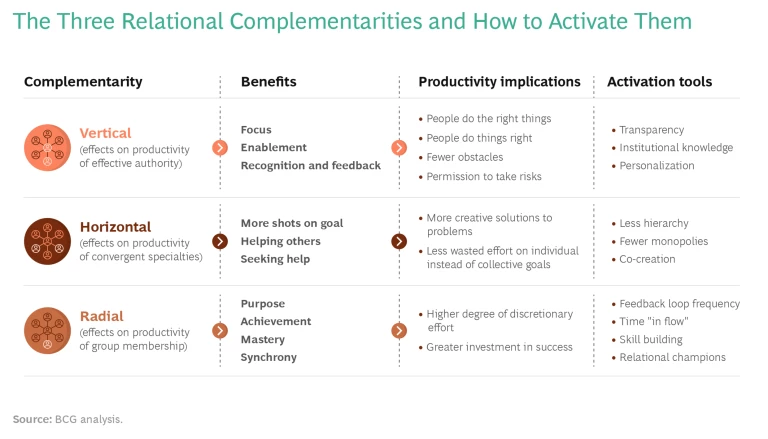The pandemic unleashed a global experiment in productivity and performance. Just as public health officials have much to learn from the crisis, so too do corporate executives.
In forcing massive numbers of people to work from home, the COVID-19 lockdowns initiated a global experiment in human behavior and productivity. How did employees accustomed to working in close proximity to colleagues adjust to working in isolation? The answer is nuanced.
Surprising signs of resilience, ingenuity, and productivity emerged. A survey of 12,000 employees in Germany, India, and the US conducted in May and June of 2020 showed that personal productivity, even in collaborative tasks, was as high or higher during the pandemic than beforehand. The Sapiens Institute, a French think tank, estimates that remote work protected €216 to €230 billion in GDP in France during the 2020 lockdowns. In the US, nearly 70% of all employees were working from home early in the pandemic, according to an oft-cited survey by Owl Labs. And yet Gallup polls show that employee engagement reached a 20-year high of 40% in late June and early July, before settling back to prepandemic levels.
We are not Panglossian. Burnout, stress, and declines in mental and physical health are all legacies of the lockdowns. The pandemic also imposed unspeakable human suffering, especially among the most vulnerable members of society, in addition to upending family life, wreaking economic havoc, and widening economic inequality.
Amid these realities, however, there are lessons to be drawn about human performance in the absence of proximity. Just as public-health officials have much to learn from the COVID crisis, so too do corporate executives. The lessons go far beyond the pros and cons of physical, hybrid, and remote work settings. More broadly, the lockdowns illuminate some previously hidden economic effects of human interaction—what we call “relational productivity”—and suggest new ways to think about what matters most in creating the conditions for productive work and in using
digital technologies
.
Productivity Without Proximity
By removing the container of the office, the pandemic exposed the actual content of work. What makes work productive, whether it occurs in the physical or the virtual world?
BCG’s article “ How the Lockdown Unlocked Real Work ” described relational productivity as the boost in performance resulting from people and groups working together. For a long time, productivity depended on proximity. The scale economies enabled by the steam engine in the 19th century and the assembly line in the 20th century depended on proximity, as do today’s agile teams working together in a designated room. But the pandemic revealed the extent to which humans can interact productively without proximity. Because the modern economy involves information, data, and knowledge, all of which are virtual, this finding is particularly relevant to understanding how best to deploy digital technologies.
These insights are supported by data from Humanyze, a workplace analytics company that measures the effects of HR, management, and
corporate real-estate
- Collaboration up and down the hierarchy rose by 27%. Executives communicated more frequently with other executives at higher and lower levels of the organization.
- Knowledge diffusion across departments increased by 24%. This was not the product of longer or larger meetings, since meetings with more than ten participants fell nearly 50% and those lasting longer than 80 minutes fell by 89%.
- Work style flexibility, or the ability to work autonomously, rose by 9%.
Contrary to prepandemic predictions, people figured out ways to remain productive without the convenience of proximity. How was that possible? One simple answer is technology, and in fact nearly all collaborative office work occurred via video. But Zoom, Slack, and other technology tools that enabled virtual collaboration are not new. So though technology is certainly part of the answer, it does not fully explain why collaboration, knowledge diffusion, and autonomy increased.
Rather, we would argue that the pandemic’s remote-work experiment forced many managers and employees to focus on the relational dimension of work. Unable to rely on proximity, they invested in connectedness. In the process, they discovered the central importance of relational productivity.
The Humanyze data may seem counterintuitive and even mysterious. How could the absence of human contact strengthen human connectedness? Two examples help us understand what was at work.
The Zoom World. For many interactions, the container of the Zoom screen replaced the container of the office. This shift to a virtual world influenced both the content of meetings and the nature of relationships among participants and between leaders and employees.
On a Zoom call, many of the traditional trappings of leadership, such as the seat at the head of the table, disappear; screen real estate is the same for everyone. This shift in perspective encouraged junior people to speak up more often and made meetings more participatory. Indeed, the Humanyze data shows that vertical collaboration rose by 27% during the pandemic. It’s also far easier to disengage discretely on a Zoom call than in a physical meeting. Without a captive audience of people seated in a closed-door meeting room, organizers and presenters had to be better prepared if they wanted to command the attention of participants.
Switching to the Zoom world during the pandemic was like replacing a traffic light with a traffic circle. Instead of just reacting to red, yellow, and green lights, drivers at a traffic circle have to slow down and pay attention to the comings and goings of other vehicles. For this reason, traffic circles are generally safer than intersections with traffic lights. They also allow more vehicles to pass, so in a sense they are more productive. Similarly, in the unforgiving Zoom setting, people become more mindful, and this mindfulness in many cases makes interactions more effective. When organizers fail to treat meetings as traffic circles, “Zoom fatigue” and other problems take hold.
Taking Sales Teams Off the Road. Being on the road and meeting with clients in person have traditionally been considered essential to sales. But even as air and other forms of travel become viable once more, many sales teams are staying home. Why?
During the pandemic, sales reps learned how to establish connections by taking advantage of AI-powered sales tools like Gong. Such tools convert the content of sales calls, video conferences, and emails into data that algorithms can analyze. The resulting data-driven insights helped reps focus on what worked and what didn’t during their sales calls. They could spend more time honing their skills and making sales rather than traveling. Gong reports that its customers experience a 44% average increase in wins and a 38% reduction in the length of the sales cycle.
Uncovering Relational Productivity
Zoom and Gong were effective during the pandemic because they created conditions that strengthened relational productivity and its three underlying “relational complementarities.” In economics, complementarity refers to how one factor in production increases the value of another, or how goods have more value when used together rather than separately. (A dishwasher and detergent, for instance, display complementarity.) Relational complementarities similarly explain how one person’s behavior can increase the contribution of others.
The pandemic demonstrated that relational complementarities depend much more on purposeful, coherent connectedness than on proximity. Proximity is the tip of the iceberg of human interaction. It provides comfortable but weak substitutes for authentic connectedness. We think we understand one another because we share the same office. We think the team is listening because we’re all at the same table. We think we know a colleague because of random encounters at the coffee machine.
The lockdowns removed these substitutes and brought into focus those organizations that valued the form over the substance of human connectedness. When the substitutes disappeared, so did productivity. But in organizations where complementarities were already strong and leaders mindfully reinforced them, productivity increased.
The three complementarities that underlie relational productivity are vertical (manager to employee), horizontal (employee to employee), and radial (employee to the organization). Vertical complementarity describes the increased productivity generated by the effective use of authority. Horizontal complementarity focuses on the economic benefit generated by the convergence of specialties. Radial complementarity explains the jump in productivity that results when people have a sense of belonging to something larger than themselves. Collectively, these complementarities, more than any enabling technology such as Zoom, magnify human effort so that the whole is greater than the sum of its parts. (For the ways in which technology can rob the power of these complementarities as easily as it can strengthen them, see “Can Zoom Solve Solow’s Paradox?”)
Can Zoom Solve Solow’s Paradox?
Why has technology not fulfilled its promise? A big reason is the failure to think about cognitive sciences, organizational sociology, and how technology affects people’s behavior and interactions. If it’s not thoughtfully deployed, digital technology can have the following weakening effects on the three aspects of relational productivity:
- Vertical Complementarities. Personal “productivity” tools such as email, online calendars, chat, and even Slack often reduce people’s ability to focus on their work. Digital calendars make it easy to invite 100 people to a meeting when only 10 might be necessary.
- Horizontal Complementarities. Unchecked, technology can interfere with cooperation by making some nonvalue-adding tasks too convenient. For example, it’s much easier for a design team to create virtual rather than physical prototypes, so unnecessary prototypes proliferate. This imposes new burdens on colleagues, who bear the full cost of resolving the tradeoffs that the designers avoided. Likewise, Slack and other messaging apps are convenient for the sender but can be a source of constant interruptions for recipients and interfere with overall productivity. Finally, the dedicated systems of specific departments—marketing, sales, and customer service, for instance—often do not communicate easily with one another. As a result, rather than encourage cooperation, they reinforce siloes and make processes more rigid.
- Radial Complementarities. One of the key benefits of membership in a group is the honing of specialized skills. And yet, technologies such as online calendars, online travel booking, and even word processing and presentation applications have allowed organizations to remove support staff. Consequently, specialists spend more time on activities such as managing calendars, sending emails, and designing slides than on their specialty. Their days include large doses of drudgery.
A surprising gift of the pandemic may be solving Solow’s paradox and bringing technology to its full potential.
Traditional organizations have focused on the vertical dimension. The most obvious manifestation is the close link between pay and promotion. But the pandemic revealed that the horizontal and radial complementarities have vast, largely unexplored potential to improve productivity. Perhaps employees who activate horizontal and radial complementarities should receive much higher compensation, even if they don’t follow the usual path of rising through the ranks.
Let’s explore each complementarity in greater depth. (See the exhibit.)
Vertical Complementarities
Through their interactions with employees, managers add value by getting people to do what they might not do on their own. This is the essence of vertical complementarity.
Benefits
When leaders effectively exert the authority assigned to them, they encourage others to perform more valuable work in three ways:
- Focus. Leaders help teams focus on the right work. They help people prioritize goals, activities, and projects and protect them from unnecessary disturbances. They ensure that people develop the most relevant skills and spend their time on what they do best while still contributing to the larger group.
- Enablement. Leaders empower teams through coaching, acting as role models, removing obstacles, providing resources, and permitting risk taking. People are more likely to experiment, innovate, and push boundaries if they know that their leaders will support them.
- Recognition and Feedback. Leaders add value through authentic praise. Recognition is not simply the distribution of rewards—a bonus, promotion, or raise; it also comes from the acknowledgment of work well done, especially when offered by someone intimately familiar with what the work involved.
These three benefits of vertical complementarity depend on leaders being involved in the real work of their people, as they were during the lockdowns. Many business leaders increased the number of people with whom they interacted. Instead of presiding at long, formal meetings with many passive participants, they spent shorter bursts of time on Zoom. By engaging directly with their teams, leaders helped them navigate through tough times. An analysis published by Harvard Business School confirmed this shift. During the pandemic, people attended 13% more meetings but these were 20% shorter in length, so the overall time spent in meetings decreased.
Leaders were also more directly exposed to their employees’ personal circumstances—especially the challenges of managing family, work, and health issues—and were more likely to offer support and acknowledge their sacrifices. The Limeade Institute, which analyzes employee experiences, has found that employees who feel cared for by their employer are twice as likely to be engaged in their work and six times more likely to remain with the company for at least three years.
Activating Vertical Complementarities
How do leaders promote the vertical complementarities that result in the benefits of focus, enablement, and recognition? And how did they do so during the pandemic?
Increase transparency. Transparency goes a long way toward increasing vertical complementarities. People have the information they need to do their jobs, and because leaders know what their teams are working on, they have better ideas about how to help them.
Information sharing is generative, fostering cooperation and coordination. The use of Zoom during the pandemic helped to increase transparency because meetings could grow in size without having to move to larger venues or blow through the travel budget. Many people who had never met their CEO or other senior executives suddenly saw them monthly or even weekly on all-hands Zoom calls. At many organizations, this was a cultural shift that will require nurturing to become permanent.
Build institutional knowledge. The example of Gong’s effect on sales shows the value of sharing best practices and knowledge in strengthening vertical complementarities. The substance of a one-on-one, in-person sales meeting is largely lost to the ages. That of a digital communication, on the other hand, can be fully captured—including even the customer’s facial expressions. This enables sales leaders to help their teams focus on the right messages and the most effective approaches, and to recognize and acknowledge skillful selling. It also enables sales executives to make more sales.
Personalize employee journeys. The pandemic exposed senior leaders to the ways in which their employees are juggling work and home life. This has begun to profoundly influence how some organizations design career paths and training. The one-size-fits-many training, development, and promotion models have been dying a long, slow death; the pandemic provided an opportunity for companies to start creating employee journeys in the same way that they create customer journeys. These should focus on employees’ individual needs and provide recognition of their specific accomplishments.
Horizontal Complementarities
When people work in teams (or teams of teams), they can take advantage of a range of individual specialties, combining their efforts to generate differential value. This convergence of specialties is the defining feature of horizontal complementarities. For example, a marketing department that provides the commercial team with the right customer targets at the right time ensures that sales reps don’t waste time on unlikely prospects.
Benefits
When horizontal complementarities are strong, work behavior improves in three ways:
- Creating More Shots on Goal. Employees with different specialties, backgrounds, and experiences bring different perspectives to a problem. Working together, they react to one another’s ideas, increasing the number of solutions and the likelihood of success. Richer and more creative ideas emerge that would not otherwise have surfaced. (This, by the way, is the value of workplace diversity.)
- Helping Others. Employees go out of their way to help their colleagues in an organization with strong horizontal complementarities. They take personal risks to support one another and find better solutions to problems. As Jørgen Vig Knudstorp, the executive chairman and former CEO of the Lego Group, puts it, “Blame is not for failure. It is for failing to help or ask for help.” Automotive engineers, for example, sacrifice design elegance in order to make vehicle servicing easier for mechanics. Members of one team pitch in to help another team that has fallen behind or is overwhelmed.
- Seeking Help. At many organizations it’s difficult to ask for help, since this can be viewed as a sign of weakness. But at organizations with strong horizontal complementarities, people are willing to take that risk because helping others is encouraged.
Employees willing to support one another can be incredibly valuable: they find better solutions to problems, are more creative, and don’t waste their efforts on low-value goals or activities. The results are less duplication of effort, fewer bottlenecks, and greater standardization. During the pandemic, this all-for-one-and-one-for-all spirit was on full display at many organizations. The urgency of the crisis encouraged people to pitch in to help their colleagues and focus on the problems at hand. They became more comfortable sharing information, as the Humanyze data showing a 24% increase in knowledge diffusion suggests. Reporting lines relaxed, and problem solving improved.
Activating Horizontal Complementarities
Executives have a range of tools to encourage horizontal complementarities and the cooperative spirit that they engender.
Break down dysfunctional hierarchy. During the pandemic, did you interact with more people more than one layer removed from you than beforehand? Did you interact with more people outside of your department or function? For most people, the answer to both questions is probably yes. In the teeth of the crisis, much of the complicatedness of the traditional work environment melted away, allowing people to generate value-adding work by cooperating with their colleagues.
When the crisis eventually recedes, the challenge will be to prevent the return of hierarchy’s dysfunctional aspects—the rigid reporting lines and siloed, not-invented-here behavior—while retaining its benefits. Technologies such as Zoom can help facilitate more fluid give-and-take interactions, but breaking down hierarchy requires cultural change. Methodologies such as agile can help, but at many organizations agile exists more in name than in practice.
Weaken internal monopolies. Monopolies develop when people do not have the proper incentives to cooperate. Experts horde information and expertise. Sales executives protect client relationships. One proven way to weaken internal monopolies is to look externally for expertise. Italian energy company Enel, for example, partnered with several crowdsourcing platforms to generate ideas from outside the company on issues ranging from recruiting to the fate of defunct thermal plants.
Foster co-creation. Wikipedia remains the standout example of the power of co-creation. But in a culture that punishes mistakes, people can be reluctant to participate in an activity that they don’t fully control. The answer is as much cultural as technological: encourage participation by forgiving the occasional error.
Radial Complementarities
Radial complementarity describes the performance boost generated when individuals are part of a group such as a company. A group can increase the intensity of its members’ efforts. The strength of this complementarity grows with the size of the group, just as a radius grows with the size of a circle.
Benefits
Before the pandemic, many leaders conferred such benefits as espresso bars, catered lunches, and yoga classes to cultivate a feeling of belonging among a company’s employees. Yet when offices plunged into darkness overnight, people kept working and performing—often even better than before. Many of them also maintained a sense of connectedness with the organization because of the four benefits conferred by radial complementarity:
- Purpose. Groups can serve a larger purpose much more easily than individuals can. As members of a group, employees can have a greater impact on customers, colleagues, stakeholders, and even society. An aspirational purpose or mission—making the world better, reducing global warming, or improving gender and racial equity—becomes more credible as the size of the group grows.
- Achievement. Members of a group can potentially achieve what they may not be able to achieve individually. The classic example is the last player off the bench of a championship basketball team. As a willing participant in practices and a positive influence from the sidelines, such a player can hold the trophy at the end of the season along with his or her teammates. In addition, with greater achievements come greater rewards, from higher compensation to greater job and career flexibility to increased value on the job market.
- Mastery. Membership in a group facilitates specialization and learning. Working alongside colleagues, an individual is encouraged to continually refine his or her skills. This is core to work satisfaction and, of course, to value on the job market.
- Synchrony. Groups give people an opportunity to connect with something larger than themselves, which confers well-documented benefits. For example, rowers and dancers have higher pain thresholds when they perform with teammates and colleagues rather than alone. People who are in sync with a group will go the extra mile to ensure that they remain in the group and that the group is successful. Conversely, they will be especially reluctant to fail, since failure could have consequences not just for the individual but for the group as well.
When radial complementarities are strong, people are more productive, more willing to take risks, and more likely to go above and beyond their job descriptions. During the pandemic, many leaders called on the power of purpose and first principles—what really matters and what really counts. By anchoring the organization’s day-to-day activities to a higher goal, they were able to unleash engagement.
Activating Radial Complementarities
Tools that strengthen radial complementarities generally aim to increase employee engagement and connection with customers and with the organization’s purpose.
Shorten and amplify feedback loops. With the ability to give and receive in-person feedback gone during the lockdowns, organizations leaned heavily on tools both low tech (pulse checks and one-minute online surveys) and high tech (such as Humanyze) to connect frequently and routinely with employees and customers. These fast-twitch practices should continue. Feedback clarifies expectations and reminds people why their work matters, but it is not enough unless leaders amplify it by acting on it.
Protect time in flow. Multitasking and interruptions increase cognitive load and decrease time “in flow,” a deep state of involvement in an activity that generates satisfaction and high performance. Technologies that block notifications, delay delivery of messages, and otherwise protect employees’ time can improve concentration and deepen their connection to work. During the pandemic, with meetings that were shorter on Zoom, workers had more time to engage in the kind of thinking that lies at the heart of insight and creativity.
Nurture skill building. Developing mastery makes us more engaged in our work. The AI tool Gong enables sales executives to spend less time on the road and more time honing their craft. E-learning courses and augmented-reality headsets can likewise improve employees’ skills. These tools have the dual benefit of increasing both productivity and loyalty.
Reward relational champions. Purpose, achievement, mastery, and synchrony are underappreciated capabilities at most organizations. Mastery, for example, can inspire others and demonstrate the value of pursuing perfection in the execution of tasks rather than chasing promotions, which frequently only result in turning a great operator into a poor leader. In an attempt to reduce inequality, some organizations—notably in the public sector—limit the top leader’s compensation to, for example, 20 times that of the lowest-paid employees. As a thought experiment, imagine the opposite: if the top engineer, designer, receptionist—or anyone who works well across departments and thus fosters horizontal complementarities—received cash compensation equivalent to that of the CEO. The stroke of the accounting pen, or a more modest decision to widen compensation bands for such employees, could dramatically acknowledge and reward those who improve overall productivity by activating these largely hidden complementarities.
By taking away the familiar container of the office, the pandemic forced our attention on the helpful and harmful roles technology can play in facilitating work, and it illuminated what makes people productive in groups. More specifically, it revealed the importance of the three relational complementarities and how they combined to improve leadership , cooperation, and engagement—and, consequently, productivity—in surprising ways. The knowledge we have gained about relational productivity would be a terrible thing to waste as we redesign the future of work.










